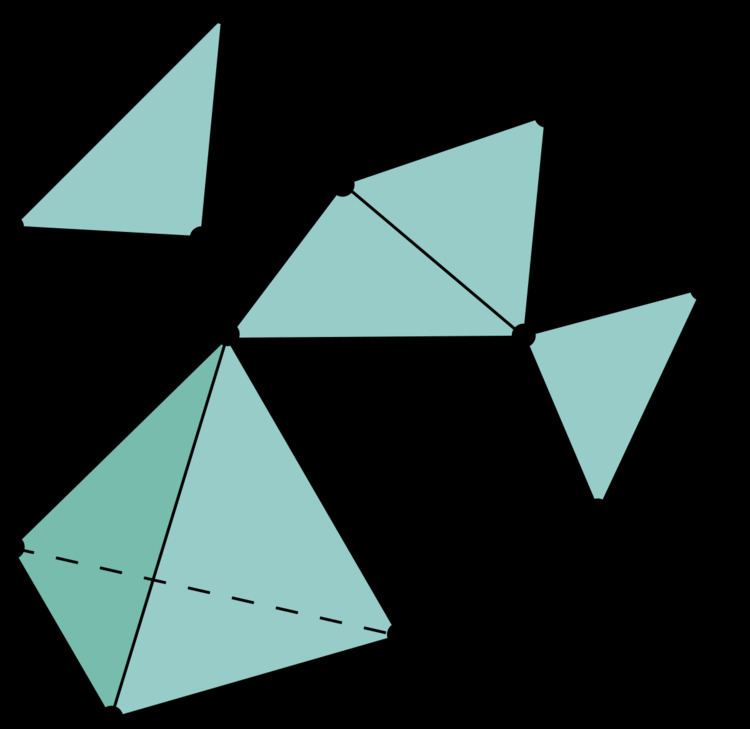 | ||
In mathematics, a simplicial complex is a set composed of points, line segments, triangles, and their n-dimensional counterparts (see illustration). Simplicial complexes should not be confused with the more abstract notion of a simplicial set appearing in modern simplicial homotopy theory. The purely combinatorial counterpart to a simplicial complex is an abstract simplicial complex.
Contents
Definitions
A simplicial complex
Note that the empty set is a face of every simplex. See also the definition of an abstract simplicial complex, which loosely speaking is a simplicial complex without an associated geometry.
A simplicial k-complex
A pure or homogeneous simplicial k-complex
A facet is any simplex in a complex that is not a face of any larger simplex. (Note the difference from a "face" of a simplex). A pure simplicial complex can be thought of as a complex where all facets have the same dimension.
Sometimes the term face is used to refer to a simplex of a complex, not to be confused with a face of a simplex.
For a simplicial complex embedded in a k-dimensional space, the k-faces are sometimes referred to as its cells. The term cell is sometimes used in a broader sense to denote a set homeomorphic to a simplex, leading to the definition of cell complex.
The underlying space, sometimes called the carrier of a simplicial complex is the union of its simplices.
Let K be a simplicial complex and let S be a collection of simplices in K.
The closure of S (denoted Cl S) is the smallest simplicial subcomplex of K that contains each simplex in S. Cl S is obtained by repeatedly adding to S each face of every simplex in S.
The star of S (denoted St S) is the union of the stars of each simplex in S. For a single simplex s, the star of s is the set of simplices having a face in s. (Note that the star of S is generally not a simplicial complex itself).
The link of S (denoted Lk S) equals Cl St S − St Cl S. It is the closed star of S minus the stars of all faces of S.
Algebraic topology
In algebraic topology, simplicial complexes are often useful for concrete calculations. For the definition of homology groups of a simplicial complex, one can read the corresponding chain complex directly, provided that consistent orientations are made of all simplices. The requirements of homotopy theory lead to the use of more general spaces, the CW complexes. Infinite complexes are a technical tool basic in algebraic topology. See also the discussion at polytope of simplicial complexes as subspaces of Euclidean space, made up of subsets each of which is a simplex. That somewhat more concrete concept is there attributed to Alexandrov. Any finite simplicial complex in the sense talked about here can be embedded as a polytope in that sense, in some large number of dimensions. In algebraic topology a compact topological space which is homeomorphic to the geometric realization of a finite simplicial complex is usually called a polyhedron (see Spanier 1966, Maunder 1996, Hilton & Wylie 1967).
Combinatorics
Combinatorialists often study the f-vector of a simplicial d-complex Δ, which is the integral sequence
By using the f-vector of a simplicial d-complex Δ as coefficients of a polynomial (written in decreasing order of exponents), we obtain the f-polynomial of Δ. In our two examples above, the f-polynomials would be
Combinatorists are often quite interested in the h-vector of a simplicial complex Δ, which is the sequence of coefficients of the polynomial that results from plugging x − 1 into the f-polynomial of Δ. Formally, if we write FΔ(x) to mean the f-polynomial of Δ, then the h-polynomial of Δ is
and the h-vector of Δ is
We calculate the h-vector of the octahedron boundary (our first example) as follows:
So the h-vector of the boundary of the octahedron is (1, 3, 3, 1). It is not an accident this h-vector is symmetric. In fact, this happens whenever Δ is the boundary of a simplicial polytope (these are the Dehn–Sommerville equations). In general, however, the h-vector of a simplicial complex is not even necessarily positive. For instance, if we take Δ to be the 2-complex given by two triangles intersecting only at a common vertex, the resulting h-vector is (1, 3, −2).
A complete characterization of all simplicial polytope h-vectors is given by the celebrated g-theorem of Stanley, Billera, and Lee.
Simplicial complexes can be seen to have the same geometric structure as the contact graph of a sphere packing (a graph where vertices are the centers of spheres and edges exist if the corresponding packing elements touch each other) and as such can be used to determine the combinatorics of sphere packings, such as the number of touching pairs (1-simplices), touching triplets (2-simplices), and touching quadruples (3-simplices) in a sphere packing.
